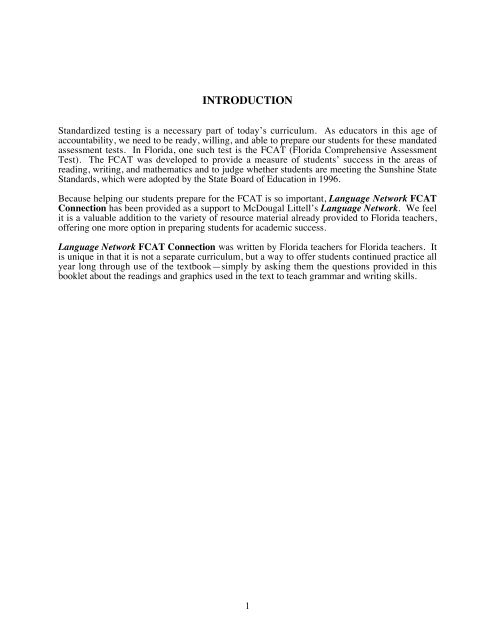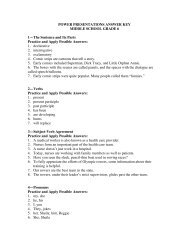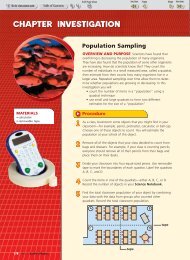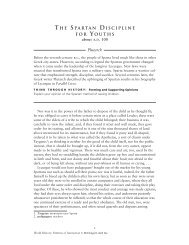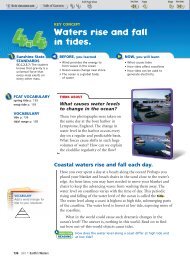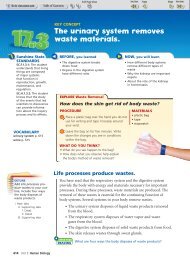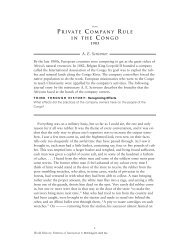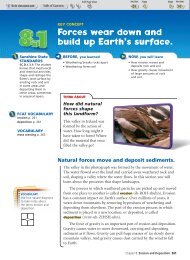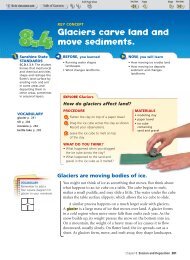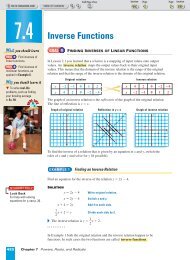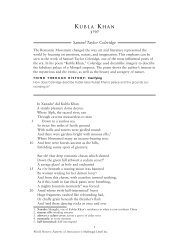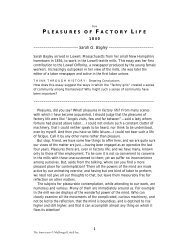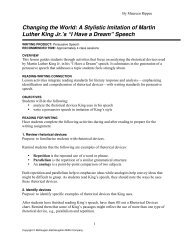INTRODUCTION - ClassZone
INTRODUCTION - ClassZone
INTRODUCTION - ClassZone
You also want an ePaper? Increase the reach of your titles
YUMPU automatically turns print PDFs into web optimized ePapers that Google loves.
<strong>INTRODUCTION</strong><br />
Standardized testing is a necessary part of today’s curriculum. As educators in this age of<br />
accountability, we need to be ready, willing, and able to prepare our students for these mandated<br />
assessment tests. In Florida, one such test is the FCAT (Florida Comprehensive Assessment<br />
Test). The FCAT was developed to provide a measure of students’ success in the areas of<br />
reading, writing, and mathematics and to judge whether students are meeting the Sunshine State<br />
Standards, which were adopted by the State Board of Education in 1996.<br />
Because helping our students prepare for the FCAT is so important, Language Network FCAT<br />
Connection has been provided as a support to McDougal Littell’s Language Network. We feel<br />
it is a valuable addition to the variety of resource material already provided to Florida teachers,<br />
offering one more option in preparing students for academic success.<br />
Language Network FCAT Connection was written by Florida teachers for Florida teachers. It<br />
is unique in that it is not a separate curriculum, but a way to offer students continued practice all<br />
year long through use of the textbook—simply by asking them the questions provided in this<br />
booklet about the readings and graphics used in the text to teach grammar and writing skills.<br />
1
A NOTE TO THE TEACHER ON HOW TO USE THIS BOOKLET<br />
Language Network FCAT Connection was written by Florida teachers for Florida teachers. It<br />
is designed to show middle school teachers how even a grammar and writing book can be used to<br />
teach reading comprehension skills. After using the FCAT practice questions that correlate with<br />
the themes, writing models, and exercises throughout the Language Network, you will be able to<br />
look at printed material with new eyes—FCAT Eyes.<br />
The reading section of FCAT asks students to read and answer comprehension questions about<br />
pieces of informational or literary text, along with graphics such as photographs, charts, graphs,<br />
and maps. Our Language Network offers a wide variety of both literary and informational<br />
passages as well as graphic images for practicing not only writing and grammar skills, but also<br />
reading comprehension skills such as those tested on FCAT. It is filled with well-written,<br />
themed paragraphs, passages taken from longer works, comic strips, charts, and maps—the<br />
perfect fodder for FCAT-styled questions.<br />
So this FCAT Connection booklet is filled with comprehension questions—multiple choice,<br />
short response, and extended response—based on material from cover to cover in Language<br />
Network. Busy teachers can photocopy these ready-made lessons or put them on transparencies<br />
for quick and easy FCAT practice all year long. In addition, teachers can copy the short and<br />
extended response answer boxes in the back of this booklet to give students practice with the<br />
actual FCAT format. These lessons also demonstrate how, once you have FCAT Eyes,<br />
everything is game for an extended or short response question. Of course, not every opportunity<br />
in the Language Network has been exploited, so you are still left with plenty of reading<br />
passages with which to practice creating your own FCAT questions.<br />
For the writing benchmarks we have provided writing prompts based on the themes of the<br />
chapters. The readings in the chapters will serve as background information to enable students to<br />
provide more support for the main ideas in their essays.<br />
We hope you will enjoy using the Language Network as we know it can be used. Use entire<br />
lessons or only a question here and there. We know you will find the Language Network<br />
textbook and the FCAT Connection booklet a joy to use in the classroom.<br />
2
Chapter One FCAT Practice<br />
Theme: Storytelling<br />
Comparison and Contrast<br />
1. “Cinderella in Asia” on page 7 and “An Endless Tale” on page 13 are both alike and<br />
different. Support this statement with details from the text. Use the extended response box to<br />
answer this question. (You may want to use a Venn Diagram to help you organize your<br />
thoughts for writing.)<br />
Cinderella Endless Tale<br />
Elements of the Story:<br />
2. Read “The Ant and the Grasshopper” on page 15.<br />
What is the conflict of this story? Support your answer with details from the story. Use the<br />
short response box to answer this question.<br />
Context Clues<br />
3. Read “Arachne” on page 28.<br />
“Arachne was used to being wondered at, and she was immensely proud of the skill that had<br />
brought so many to look on her.” The best meaning of wondered is<br />
A. respected.<br />
B. feared.<br />
C. dishonored.<br />
D. disrespected.<br />
3
Elements of the Story<br />
4. Read “The Hare and the Tortoise” on page 29.<br />
A character word that could be used to describe the tortoise is determination. Do you agree?<br />
Support your answer with details from the text. Use the short response box to answer this<br />
question.<br />
Cause and Effect<br />
5. Read the selection “A Storytelling Tapestry” on page 29.<br />
The main reason that the tapestry was made was<br />
A. to pay honor to William of Normandy.<br />
B. to tell the story of the life of William of Normandy.<br />
C. to highlight the kingdom of Normandy.<br />
D. to teach about life in the Middle Ages.<br />
FCAT Writing Prompt<br />
WRITING SITUATION<br />
Most students have heard stories that have a moral or lesson.<br />
Think about one of these stories and how it could be used to teach your friend a lesson.<br />
WRITING INSTRUCTIONS<br />
Now write to explain your story choice and the lesson that your friend will learn.<br />
4
Chapter One Answer Key<br />
1. LA.A.2.2.7 Recognizes the use of comparison and contrast in a text.<br />
-oldest version from<br />
China<br />
-dead gold fish from<br />
wise man<br />
-loses slipper at party<br />
-king searches for her<br />
A top-score response would be similar to the following:<br />
“Cinderella in Asia” and “An Endless Tale” are both alike and different. China’s<br />
“Cinderella” is the oldest version. Cinderella who has a bad home life receives a dead gold<br />
fish from a wise old man. She attends a party and loses her slipper. The king then seeks her.<br />
On the other hand, in “An Endless Tale” it is the princess that is hunting for a husband<br />
who must be a good storyteller. The man she chooses to marry tells a story about a locust<br />
and corn. Both stories are alike because they are tales that have been passed on over time ,<br />
and both have the main character finding a person to marry.<br />
2. LA.E.2.3.2 Recognizes complex elements of plot, including setting, character<br />
development, conflicts, and resolutions.<br />
A top-score response would be similar to the following:<br />
The conflict is hard work vs playtime. The ant worked hard and prepared for the upcoming<br />
cold weather. Meanwhile, the grasshopper played and sang, acts which led to his suffering.<br />
In the end, the ant’s hard work led to success.<br />
3. LA.A.1.3.2. Uses a variety of strategies to analyze words and text, draw conclusions,<br />
use context and word structure clues, and recognize organizational patterns.<br />
The correct answer is A.<br />
-stories<br />
passed on<br />
-both find<br />
a husband<br />
5<br />
-princess searching<br />
for a husband<br />
-man must be a good<br />
storyteller<br />
-marries him<br />
-tell story about locust<br />
and corn
4. LA.E.2.3.2 Recognizes complex elements of plot, including setting, character<br />
development, conflicts, and resolutions.<br />
A top-score response would be similar to the following:<br />
The tortoise could be characterized as determined because the tortoise never stopped. He<br />
went without food and water, and he never rested. He was determined to beat the hare in the<br />
race.<br />
5. LA.E.2.2.1 The student recognizes cause-and-effect relationships in literary texts.<br />
The correct answer is D.<br />
6
Chapter Two FCAT Practice<br />
Theme: Ancient Civilizations<br />
Author’s Purpose<br />
1. Read the corrected version below of “Garbage In, Knowledge Out” from page 40.<br />
Can you imagine archaeologists going through your trash? People who excavate, or dig up,<br />
lost cities do exactly that! They find artifacts that provide us with echoes of the past. An<br />
artifact is any object men, women, and children use in their daily lives. Today’s scientists<br />
examine pottery, tools, and other objects used by ancient communities. A future scientist<br />
may examine your mattresses, your toothbrushes, or your baby toys! A scientist today may<br />
look at bones to see which animals people ate, such as deer or buffalo. A future excavator<br />
may examine the leftover tomatoes in your salad. Here’s a hint. Keep your old dishes<br />
clean, in case they’re ever seen!<br />
The author’s purpose for writing this selection was<br />
A. to educate the reader about what an archaeologist studies and does.<br />
B. to inform that an artifact is really a daily life item.<br />
C. to suggest what objects could be studied from the past.<br />
D. to amuse the reader with a joke about doing dishes.<br />
Supporting Details<br />
2. Read the corrected version below of “Risen from a Watery Grave” from page 42.<br />
The Mary Rose was one of England’s finest warships. She sank to the Portsmouth Harbor’s<br />
seabed during a battle with the French fleet in 1545. Many eyewitnesses’ accounts told of<br />
her sad end. The Mary Rose quickly became covered with the seabed’s mud and sand.<br />
Alexander McKee located the wreck’s position in 1965. In 1982 the ship was raised and<br />
stored in the city’s dry dock. Bows, arrows, and other archers’ equipment were found on the<br />
gundeck. Other weapons were found in the sailors’ cabins. Netting kept the Mary Rose’s<br />
sailors from escaping when the ship sank. The Mary Rose and its artifacts tell us about the<br />
seamen’s lives onboard the ship.<br />
The raising of the Mary Rose was like finding a treasure chest for archaeologists. Support<br />
this statement with details from the text. Use the following organizer to help you with<br />
writing an extended response.<br />
7
Use the extended response box to answer the question.<br />
Inference<br />
3. Read all the statements about the Aztecs on pages 43 and 44.<br />
Why did the Spanish attack the Aztecs? Support your conclusion with details from the text.<br />
Use the short response box to answer this question.<br />
NOTE: Writing Practice located on page 47 is written in the form of a cause-and-effect FCAT<br />
question.<br />
Comparison and Contrast<br />
4. Read “Nouns and Their Jobs” on page 48.<br />
Mary Rose is like a treasure chest for archaeologists.<br />
The dinosaur and the other animals of that time were alike but different. Support this<br />
statement with details from the text. Use the short response box to answer this question.<br />
8
Author’s Purpose<br />
5. Read the selection on page 49.<br />
The author’s purpose for writing this text was<br />
A. to inform who the Croatoans really were.<br />
B. to suggest why the colonists wrote Croatoan.<br />
C. to educate about the early English colonists.<br />
D. to draw a conclusion about the colonists’ disappearance.<br />
Main Idea and Supporting Details<br />
6. Write a title for the selection about the English colonists on page 49, and support your title<br />
with details from the text. Use the extended response box to answer this question.<br />
FCAT Writing Prompt<br />
WRITING SITUATION<br />
By the sixth grade students are aware of the problems of too much garbage.<br />
Think about some ways trash disposal could be improved.<br />
WRITING INSTRUCTIONS<br />
Now write to convince your local government officials to use your ideas to improve garbage<br />
disposal in your area.<br />
9
Chapter Two Answer Key<br />
Note to the teacher: The graphic organizer located in this section is a good way to help your<br />
students with finding three to four details from the text to support their answers. Detailed<br />
answers will receive a top score on the extended response portions of the FCAT.<br />
1. LA.A.2.3.2 Identifies the author’s purpose and/or point of view in a variety of texts<br />
and uses the information to construct meaning.<br />
The correct answer is C.<br />
2. LA.A.2.3.1 Determines the main idea or essential message in a text and identifies the<br />
relevant details and facts and patterns of organization.<br />
A top score would be similar to the following:<br />
The finding of the Mary Rose was like a treasure chest because many artifacts were found.<br />
These artifacts were the weapons used during that time period. Because of the netting, the<br />
weapons were not washed away, and the archaeologists could see that the men had been<br />
fighting using archery equipment. Other weapons were found in the cabins. This discovery<br />
also gave insight into what the life of a seaman was like at that time.<br />
3. LA.A.1.3.2. Uses a variety of strategies to analyze words and text, draw conclusions,<br />
use context and word structure clues, and recognize organizational patterns.<br />
A top-score response should be similar to the following:<br />
The Aztecs had many precious metals including gold and silver. Thus, the Aztecs had<br />
enemies who wanted to steal their riches. The Spanish attacked the Aztecs during the<br />
Spanish conquest of Mexico and defeated their empire.<br />
4. LA.A.2.2.7 Recognizes the use of comparison and contrast in a text.<br />
A top-score response should be similar to the following:<br />
The dinosaur and the other animals of that time were different. The dinosaurs were very<br />
huge , only survived 160 million years, but became extinct without a sure reason why. On<br />
the other hand , the other animals were mammals, and they had a much easier time finding<br />
food because of their smaller size. The only thing that the dinosaur and the other animals<br />
had in common was the fact that both were life forms of that time.<br />
5. LA.A.2.3.2 Identifies the author’s purpose and/or point of view in a variety of texts<br />
and uses the information to construct meaning.<br />
The correct answer is D.<br />
6. LA.A.2.3.1 The student determines the main idea or essential message in a text and<br />
identifies the relevant details and facts and pattern of organization.<br />
Answers will vary, but students must have details from the selection to support their title.<br />
10
Chapter Three FCAT Practice<br />
Theme: Friendships<br />
Main Idea and Supporting Detail<br />
1. Read the corrected version below of “Revising: Substituting Pronouns for Nouns” from<br />
page 56.<br />
In ancient times, the idea of friendship was foreign to many people. They didn’t even<br />
have a word for “friend.” In Old English, though, the word friend did exist. It first<br />
appeared in English in A.D. 1018.<br />
Most ancient people lived in close communities. They had litle contact with outsiders.<br />
These people did have a word for “stranger.” It meant “enemy.”<br />
Today, we meet “strangers” all the time. Are these strangers enemies? Most of them<br />
are not. In fact, many strangers will become our friends.<br />
Write a title for this passage and support your title with details from the text. Use the<br />
extended response box to answer this question.<br />
Inference<br />
2. You can conclude from the previous passage that our language has grown and changed.<br />
Support this statement with details from the text. Use the short response box to answer this<br />
question.<br />
Context Clue<br />
3. The following statement came from “The Sailors’ Friend” on page 60.<br />
“Pelorus Jack guided ships through the dangerous Cook Strait near New Zealand. The best<br />
meaning for strait is<br />
A. distress.<br />
B. channel.<br />
C. isle.<br />
D. narrow.<br />
Cause and Effect<br />
4. Read the Student Model selection on page 62.<br />
An active volcanic eruption can have a chain of effects. (This is similar to a<br />
cause-and-effect chain where a cause produces an effect which then becomes a cause to<br />
produce another effect.) Support this statement with details from the selection. Use the short<br />
response box for your answer.<br />
Main Idea<br />
5. Read “All for One and One for All” on page 65.<br />
What is the main idea for this selection?<br />
A. Imitate the way the pros play to be good at the sport.<br />
B. “Don’t worry about how well you play; just enjoy it.”<br />
12
C. Your best friends will be those with whom you play sports.<br />
D. Team players think of others and not just themselves.<br />
Author’s Purpose<br />
6. Read “Writing: Science Questions and Answers” on page 68.<br />
The author’s purpose for writing this selection was<br />
A. to share Penny’s personal experience with Koko.<br />
B. to show how sign language can be taught to animals.<br />
C. to inform inform the reader about animals and their training.<br />
D. to entertain with an animal’s ability to communicate.<br />
Elements of the Story<br />
7. Read the selection ”Number the Stars” on page 71.<br />
What is the conflict in this selection? Support your answer with details from the text. Use<br />
the short response box to answer this question.<br />
Reading charts, graphs, etc.<br />
8. Read the selection “Drafting from a Timeline” on page 79.<br />
Why was Harriet Tubman nicknamed Moses? Support your answer with details from the<br />
text. Use the short response box to answer this question.<br />
Main Idea and Supporting Details<br />
9. Read the selection “Writing: Using Pronouns in Dialogue” on page 81.<br />
Clifton Davis had loyal friends. Support this statement with details from the text. Use the<br />
short response box to answer this question.<br />
FCAT Writing Prompt<br />
WRITING SITUATION<br />
Most teens are familiar with peer pressure.<br />
Think about peer pressure and decide whether it is a good thing or a bad thing.<br />
WRITING INSTRUCTIONS<br />
Now write giving your opinion on peer pressure.<br />
13
Chapter Three Answer Key<br />
1. LA.A.2.3.1 Determines the main idea or essential message in a text and identifies the<br />
relevant details and facts and patterns of organization.<br />
The title chosen must be supported with details from the selection.<br />
2. LA.A.1.3.2. Uses a variety of strategies to analyze words and text, draw conclusions,<br />
use content and word structure clues, and regular organizational patterns.<br />
A top-score response would be similar to the following:<br />
Our language has grown because we have had to add new words to name things. For<br />
example, the word friend was added in 1018. The word stranger also had to be added<br />
because people lived in close communities and did not encounter many new people. Also,<br />
words changed their meanings as society changed; for example, stranger once meant enemy.<br />
3. LA.A.1.3.2. Uses a variety of strategies to analyze words and text, draw conclusions,<br />
use context and word structure clues, and recognize organizational patterns.<br />
The correct answer is B.<br />
4. LA.E.2.2.1 Recognizes cause-and-effect relationships in literary texts.<br />
A top-score response should be similar to the following:<br />
A volcanic eruption at sea causes the formation of a tsunami wave that heads toward land.<br />
This wave can move at a rate of 500 miles per hour and reach a height of 170 feet. When<br />
this tsunami hits land, it destroys anything in its path. Thus, an eruption at sea will lead to<br />
devastating effects on land.<br />
5. LA.A.2.3.1 Determines the main idea or essential message in a text and identifies<br />
relevant details and facts and patterns of organization.<br />
The correct answer is D.<br />
6. LA.A.2.3.2 Identifies the author’s purpose and/or point of view in a variety of texts<br />
and uses the information to construct meaning.<br />
The correct answer is B.<br />
7. LA.E.2.3.2 Recognizes complex elements of plot, including setting, character<br />
development, conflicts, and resolutions.<br />
A top-score response would be similar to the following:<br />
The conflict is the Nazis vs the Jews or man vs man. This conflict is what changed the lives<br />
of Annemarie and Ellen. Ellen must go into hiding, and Annemarie supports her friend.<br />
14
8. LA.A.2.3.5 Locates, organizes, and interprets written information for a variety of<br />
purposes, including classroom research, collaborative decision making, and<br />
performing a school or real-world task.<br />
A top-score response would be similar to the following:<br />
Harriet Tubman was nicknamed Moses because between 1849 and 1860 she helped lead<br />
people from slavery to freedom like Moses. She helped over three hundred people escape<br />
by showing them the way on the Underground Railroad.<br />
9. LA.A.2.3.1 Determines the main idea or essential message in a text and identifies<br />
relevant details and facts and patterns of organization.<br />
A top-score response would be similar to the following:<br />
Clifton Davis’s friends were very loyal. When Clifton was denied entrance to the Glenn<br />
Echo Amusement Park due to his color, his friends refused to go also. They all really<br />
wanted to go, but they decided to stand up for their friend’s rights.<br />
15
Chapter Four FCAT Practice<br />
Theme: Transportation<br />
Supporting Details<br />
1. Read “They Got Around” on page 90.<br />
Many forms of transportation were developed thousands of years ago, yet they are still in use<br />
today. Support this statement with details from the text. Use the extended response box to<br />
answer this question.<br />
Cause and Effect<br />
2. Read “The First Accidents” on page 93.<br />
Nicholas-Joseph Cugnot became famous for several reasons. Support this statement with<br />
details from the text. Use the short response box to answer this question.<br />
Use the following graphic organizer to help you prepare a written response.<br />
Cause<br />
Cause<br />
Cause<br />
Cause and Effect<br />
3. Read a “A Flying First” on page 95.<br />
Bessie Coleman became the first African-American pilot because<br />
A. she learned to fly from WW II pilots.<br />
B. she studied flying in France.<br />
C. she studied flying in Texas.<br />
D. she studied to overcome poverty.<br />
Author’s Purpose and Reading Charts, Graphs, Timelines<br />
4. Read the corrected version below of “Moving Through History” from page 100.<br />
Transportation began before civilization. For centuries, people walked and ran everywhere.<br />
They first rode in dugout canoes and reed boats nearly 10,000 years ago. They began using<br />
animals to carry their loads by 4000 B.C. They drove chariots with solid wheels by 2500<br />
B.C. They dug canals for ship traffic soon thereafter. Spoked wheels made their appearance<br />
around 2000 B.C., and the Greeks built light fast ships around 400 B.C. The Roman Empire<br />
16<br />
Effect
saw advances in road building, and in A.D. 80, Roman gladiators in the Coliseum were<br />
raised to the arena on elevator-like lifting platforms.<br />
The author’s purpose for writing this selection was<br />
A. to inform us about how people traveled 10,000 years ago.<br />
B. to educate us about travel developments as history progressed.<br />
C. to explain how the Roman gladiators made it to the Coliseum.<br />
D. to urge people to walk and run more today.<br />
5. Use this selection to create a timeline that shows the development of transportation.<br />
8,000 B.C.<br />
.<br />
Main Idea and Supporting Details<br />
6. Read the corrected version of “It’s Off to Work They Go” from page 110.<br />
Commuters have used mass transit since the 1800’s. The first electric subway was opened in<br />
Budapest, Hungary, in 1893. In 1897 Boston became the first U.S. city with a subway.<br />
After subways had run for a few decades, they improved. They ran faster and were better<br />
ventilated. Now many cities enjoy computer-controlled trains. These automatic commuter<br />
trains carry millions of people every day. Bullet trains like those in Japan now travel around<br />
190 miles per hour over long distances. The next generation of subway trains will move<br />
without engines or rails. These “maglev” trains will float on a magnetic cushion at 300 miles<br />
per hour.<br />
Mass transit has improved over time. Support this statement with details from the text. Use<br />
the extended response box to answer this question.<br />
Context Clues<br />
7. Reread the section above, paying careful attention to the word ventilated. The best<br />
definition for “maglev” is<br />
A. heavy.<br />
17
B. computer-controlled.<br />
C. strange.<br />
D. floating.<br />
Author’s Purpose<br />
8. Read the corrected version below of the Mastery Test on page 117.<br />
We are now living in the age of the automobile, but some people have worried about that fact<br />
for awhile. Cars give us freedom and mobility, but they also give us pollution, accidents, and<br />
road rage. Before the automobile age, there had been almost no pavement in the United<br />
States. Now we have 2.4 million miles of paved roads, which cost $200 million per day to<br />
keep up and add to. Some futurists believe that as roads get more crowded, more people will<br />
turn to mass transit. Even now, subways, trains, and buses pollute less per person than<br />
automobiles do. Other people predict that communities will become more self-sufficient.<br />
After people finally work near their homes, they will abandon their cars. The air will be<br />
cleaner, and people will be healthier.<br />
18
The author’s purpose for writing this selection was<br />
A. to educate about the unwelcome results of the automobile.<br />
B. to explain how we can help with getting cleaner, healthier air.<br />
C. to urge communities to become more self-sufficient .<br />
D. to explain the high costs of roads and their upkeep.<br />
Context Clues<br />
9. “Cars give us freedom and mobility, but they also give us pollution, accidents and road<br />
rage.” The best definition for mobility could be<br />
A. permanence.<br />
B. changeability.<br />
C. trailer.<br />
D. movability.<br />
Context Clues<br />
10. “Other people predict that communities will become more self-sufficient.” The best<br />
meaning for self- sufficient is<br />
A. independent.<br />
B. dependent.<br />
C. helpless.<br />
D. conceited.<br />
FCAT Writing Prompt<br />
WRITING SITUATION<br />
By the time they are in sixth grade, most students are aware of the negative effects of the car<br />
used as transportation.<br />
Think about the car and some ways you think the country could improve transportation.<br />
WRITING INSTRUCTIONS<br />
Now, write to convince the government to use your ideas to improve the transportation system.<br />
19
Chapter Four Answer Key<br />
1. LA.A.2.3.1 Determines the main idea or essential message in a text and identifies<br />
relevant details and facts and patterns of organization.<br />
A top-score response would resemble the following:<br />
Thousands of years ago several forms of transportation were invented. First, they learned to<br />
use animals to help with transporting goods. Next, in 5000 BC they invented sledges to help<br />
carry heavy loads. Later in 500 BC the wheel was designed. Yet, all of these transportation<br />
forms can still be seen in use today.<br />
2. LA.E.2.2.1 Recognizes cause-and-effect relationships in literary texts.<br />
A top-score response would be similar to the following:<br />
Nicholas-Joseph Cugnot became famous for several reasons. First, he invented the first car,<br />
which had three wheels and only moved about three mph. He also was the first man to be<br />
involved in a car accident when he hit a wall. These two effects made Cugnot famous.<br />
3. LA.E.2.2.1 Recognizes cause-and-effect relationships in literary texts.<br />
The answer is B.<br />
4. LA.A.2.3.2 Identifies the author’s purpose and/or point of view in a variety of texts<br />
and uses the information to construct meaning.<br />
The answer is B.<br />
20
5. LA.A.2.3.5 Locates, organizes, and interprets written information for a variety of<br />
purposes, including classroom research, collaborative decision-making, and performing<br />
a school or real-world task.<br />
10,000 B.C. dugout canoes and reed boats<br />
4000 B.C. animals and carrying<br />
2500 B.C. solid wheeled chariots<br />
canals for better shipping<br />
2000 B.C. spoked wheels<br />
400 B.C. Faster sailing vessels<br />
80 A.D. Road construction/elevator<br />
6. LA.A.2.3.1 Determines the main idea or essential message in a text and identifies<br />
relevant details and facts and patterns of organization.<br />
A top-score response would resemble the following:<br />
Mass transit has been improved over time. In1893 the first electric subway was started.<br />
Then improvements to the subway led to better ventilation and more speed. Later came the<br />
computer-controlled trains, which led to the bullet train that can reach speeds of 190 miles<br />
per hour. Next will be the “maglev” which will reach speeds of 300 miles per hour. Thus,<br />
mass transit has been improving over time.<br />
7. LA.A.1.3.2. Uses a variety of strategies to analyze words and text, draw conclusions,<br />
use context and word structure clues, and recognize organizational patterns.<br />
The answer is D.<br />
8. LA.A.2.3.2 Identifies the author’s purpose and/or point of view in a variety of texts<br />
and uses the information to construct meaning.<br />
The answer is A.<br />
9. LA.A.1.3.2. Uses a variety of strategies to analyze words and text, draw conclusions,<br />
use context and word structure clues, and recognize organizational patterns.<br />
The answer is D.<br />
21
10. LA.A.1.3.2. Uses a variety of strategies to analyze words and text, draw conclusions,<br />
use context and word structure clues, and recognize organizational patterns.<br />
The answer is A.<br />
22
Chapter Five FCAT Practice<br />
Theme: Vacation Spots<br />
Main Idea and Supporting Detail<br />
1. Read the Diagnostic Test on page 121.<br />
Yellowstone is considered an American treasure. Support this statement with details from<br />
the text. Remember to organize your thoughts, using the graphic organizer to prepare your<br />
response. Use the extended response box to answer this question.<br />
Yellowstone- an American treasure<br />
Inference<br />
2. Read “Why It Matters in Writing” on page 125.<br />
You can infer that Mama’s childhood made a major impact on her adult views. Support this<br />
statement with details from the text. Use the short response box to answer this question.<br />
Cause and Effect<br />
3. Read “Look Out” on page 126.<br />
Volcanic eruptions can cause serious effects. Support this statement with details from the<br />
text. Use the extended response box to answer this question.<br />
23
Inference<br />
4. Mt. St. Helen’s previous volcanic activity was in<br />
A. 1850s.<br />
B. 1860s.<br />
C. 1870s.<br />
D. 1880s.<br />
Context Clue<br />
5. Read “Climb Every Mountain” on page 129.<br />
Urban climbers scale city buildings. The best definition for urban is<br />
A. community.<br />
B. country.<br />
C. capitol.<br />
D. city.<br />
Author’s Purpose<br />
6. Read the Mastery Test on page 143.<br />
The author’s purpose for writing this selection was<br />
A. to entertain the reader about an influential biologist.<br />
B. to explain the harmful effects of the pesticide DDT.<br />
C. to inform the reader how Carson got DDT banned.<br />
D. to urge for more careful use of harmful pesticides.<br />
Context Clues<br />
7. The pesticide DDT was finally banned in 1972. The best definition for banned is<br />
A. permitted.<br />
B. allowed.<br />
C. prohibited.<br />
D. sanctioned.<br />
24
FCAT WRITING PROMPT<br />
WRITING SITUATION<br />
Most students have had an opportunity to visit a local or national park.<br />
Think about parks and whether you feel they are needed or not.<br />
WRITING INSTRUCTIONS<br />
Now write to explain your opinion on parks and why we need them.<br />
25
Chapter Five Answer Key<br />
1. LA.A.2.3.1 Determines the main idea or essential message in a text and identifies<br />
relevant details and facts and patterns of organization.<br />
Details for graphic organizer and for use in the response:<br />
-hot springs, mud pots, geysers like Old Faithful<br />
-Grand Prismatic Spring’s rainbow due to algae growth<br />
-wildlife like elk, buffalo, bighorn sheep<br />
-millions of tourists yearly<br />
2. LA.A.1.3.2. Uses a variety of strategies to analyze words and text, draw conclusions,<br />
use context and word structure clues, and recognize organizational patterns.<br />
A top-score response would resemble the following:<br />
Since Mama grew up poor and lonely, as an adult she was concerned about others and<br />
wanted to help out. She also taught her children that indifference is a character fault so that<br />
they would learn to be kind and caring.<br />
3. LA.E.2.2.1 Recognizes cause-and-effect relationships in literary texts.<br />
A top-score response would resemble the following:<br />
Volcanic eruptions have serious effects. They cause widespread damage due to fires that are<br />
sparked form the hot ashes. Second, mud slides cover the forests and make them appear<br />
flat. The eruption also pollutes the air with smoke and ash. Thus, volcanic eruptions have<br />
serious effects<br />
4. LA.A.1.3.2. Uses a variety of strategies to analyze words and text, draw conclusions,<br />
use context and word structure clues, and recognize organizational patterns.<br />
The correct answer is B.<br />
26
5. LA.A.1.3.2. Uses a variety of strategies to analyze words and text, draw conclusions,<br />
use context and word structure clues, and recognize organizational patterns.<br />
The correct answer is D.<br />
6. LA.A.2.3.2 Identifies the author’s purpose and/or point of view in a variety of texts<br />
and uses the information to construct meaning.<br />
The correct answer is C.<br />
7. LA.A.1.3.2. Uses a variety of strategies to analyze words and text, draw conclusions,<br />
use context and word structure clues, and recognize organizational patterns.<br />
The correct answer is C.<br />
27
Chapter Six FCAT Practice<br />
Theme: Dragons<br />
Context Clue<br />
1. Read about prepositional phrases and the examples on page 149.<br />
Fifty people walk under the enormous dragon. The best definition for enormous is<br />
A. tiny.<br />
B. vast.<br />
C. small.<br />
D. immense.<br />
Comparison and Contrast<br />
2. Read “Dragon Tales” on page 150.<br />
Eastern dragons are very different from the Western dragons. Support this statement with<br />
details from the text. Use the extended response box to answer this question.<br />
Eastern dragon Western dragon<br />
Cause and Effect<br />
3. Read the selection “The Largest Lizard” on page 153.<br />
The best reason to fear the Komodo lizard is that<br />
A. its saliva has bacteria in it.<br />
B. its teeth can tear up animal.<br />
C. it is the largest lizard in the world.<br />
D. it runs twelve and one-half miles an hour.<br />
Supporting Details/Comparison and Contrast<br />
4. Read the selection “Crocodiles and Alligators” on page 156.<br />
The best way to tell the difference between the crocodile and the alligator is<br />
A. snout differences.<br />
B. hunting differences.<br />
C. teeth differences.<br />
D. climate differences.<br />
28
Supporting Details<br />
5. Read the corrected version below of “Famous Dragons” from page 160.<br />
Dragons are famous around the world. The Eastern Spiritual Dragon-- Shen-Lung -- controls<br />
the wind and the rain. The Chinese Yellow Dragon gave the knowledge of writing to<br />
Emperor Fu Hsi. People fear but respect the European dragons. The Vikings put dragon<br />
figureheads on their ships. They believed the dragons would give them keen sight and skill.<br />
Beowulf confronted a dragon in the epic poem Beowulf. The dragon has become an official<br />
part of the Prince of Wales’s armor. Sea serpents are dragons from the seas. “Nessie,” the<br />
Loch Ness Monster, is a sea serpent , but she lives in a lake in Scotland.<br />
Some cultures give dragons credit for helping mankind. Support this statement with details<br />
from the text. Use the short response box to answer this question.<br />
FCAT Writing Prompt<br />
WRITING SITUATION<br />
People have strong feelings about the value of zoos.<br />
Think about zoos and whether you feel they are a good or bad thing.<br />
WRITING INSTRUCTIONS<br />
Now write to give your opinion of zoos.<br />
29
Chapter Six Answer Key<br />
1. LA.A.1.3.2. Uses a variety of strategies to analyze words and text, draw conclusions,<br />
use context and word structure clues, and recognize organizational patterns.<br />
The correct answer is D.<br />
2. LA.A.2.2.7 Recognizes the use of comparison and contrast in a text.<br />
A top-score response would resemble the following:<br />
Eastern dragons are very different from Western dragons. The Eastern<br />
dragons protect the waters, have no wings, hold a fan with their tails, and eats swallows. On<br />
the other hand, the Western dragons are associated with evil and have wings to fly above<br />
their enemies. They also can change shapes and are usually in a struggle with a knight. The<br />
only thing that these two dragons have in common is that they are dragons.<br />
3. LA.E.2.2.1 Recognizes cause-and-effect relationships in literary texts.<br />
The correct answer is B.<br />
4. LA.A.2.2.7 Recognizes the use of comparison and contrast in a text.<br />
LA.A.2.3.1 Determines the main idea or essential message in a text and identifies<br />
relevant details and facts and patterns of organization.<br />
The correct answer is C.<br />
-holds fan with tail<br />
-has no wings<br />
-protects waters<br />
-eats swallows<br />
5. LA.A.2.3.1 Determines the main idea or essential message in a text and identifies<br />
relevant details and facts and patterns of organization.<br />
A top-score response would resemble the following:<br />
Some cultures give dragons credit for helping mankind. For example, the Chinese Yellow<br />
Dragon helped by giving writing ability to the emperor. Also, The Vikings believed that a<br />
dragon symbol on their ships would enable them to have keen sight and skill.<br />
30<br />
-is associated with evil<br />
-has wings to fly above<br />
enemies<br />
-changes shapes<br />
-is usually in conflict with<br />
a knight
Chapter Seven FCAT Practice<br />
Theme: Team Participation<br />
Supporting Details<br />
1. Read the corrected version below of “Meet the Beatles” from page 168.<br />
Rock critics consider the Beatles one of the most important groups in rock and roll history.<br />
Their musical development shows constant growth and exploration. In the late 1950s they<br />
were playing other people’s songs in clubs. However, their own compositions were<br />
changing popular music. Beatle songs attract listeners who like great melodies and clever<br />
lyrics. By the mid-1960s they were performing to huge crowds in stadiums. Adults<br />
remember mobs of young fans screaming at Beatles’ concerts. The Beatles were considered<br />
wild in their day. Such popular groups affect clothing and hair styles. Today their music still<br />
plays around the world.<br />
The Beatles were considered important to rock and roll for several reasons. Support this<br />
statement with details from the text. Use the short response box to answer the question.<br />
Context Clues<br />
2. Read the corrected version below of the Student Model on page 168.<br />
Do you dislike order and discipline? Then you probably don’t belong in a marching<br />
band. The band members must follow precise directions. A music director plans out every<br />
movement? Often the musicians form words and patterns as they walk. Even their<br />
uniforms match perfectly. Many schools hav e formed marching bands. The bands play at<br />
sporting events and other special occasions.<br />
“The band members must follow precise directions. A music instructor plans out every<br />
movement . Often the musicians form words and patterns as they walk.” The best meaning<br />
for precise is<br />
A. wrong.<br />
B. exact.<br />
C. loose.<br />
D. inaccurate.<br />
Author’s Purpose<br />
3. Read the corrected version below of “Guiding Lights” from page 175.<br />
Everyone has heard of seeing eye dogs. Few know the term hearing dogs. All of these<br />
dogs alert their owners to sounds of danger. Several of the dog breeds are especially suited<br />
for work with visually challenged people. Some of the best dogs include German<br />
shepherds, Labrador retrievers, and golden retrievers. Most of the states guarantee access<br />
rights to guide-dog users. No one in these states is allowed to keep people with guide-dogs<br />
from public places. Everyone recognizes a seeing-eye dog by its special harness and Ushaped<br />
handle. Many know that hearing dogs have a bright yellow or orange collar and<br />
leash. Both of the canine helpers give visually challenged and hearing-impaired people<br />
more independence.<br />
The author’s purpose for writing this selection is<br />
A. to urge people to allow guide dogs into public places.<br />
B. to educate us about the two types of helping dogs and their jobs.<br />
31
C. to entertain us with a story about helping dogs and their duties.<br />
D. to inform the reader of the colors used for hearing dogs’ leashes.<br />
FCAT Writing Prompt<br />
WRITING SITUATION<br />
As sixth graders, many of you have already played on a team.<br />
Think about that team and decide some ways a team helps you.<br />
WRITING INSTRUCTIONS<br />
Now write to explain how being on a team has helped you.<br />
32
Chapter Seven Answer Key<br />
1. LA.A.2.3.1 Determines the main idea or essential message in a text and identifies<br />
relevant details and facts and patterns of organization.<br />
A top-score response would resemble the following:<br />
The Beatles’ music changed and grew as they played together, and their development began<br />
to change popular music. People were drawn to their songs because of the lyrics and the<br />
great melodies, which led to their performing huge concerts in stadiums. Their music is still<br />
played worldwide today.<br />
2. LA.A.1.3.2. Uses a variety of strategies to analyze words and text, draw conclusions,<br />
use context and word structure clues, and recognize organizational patterns.<br />
The correct answer is B.<br />
3. LA.A.2.3.2 Identifies the author’s purpose and/or point of view in a variety of texts<br />
and uses the information to construct meaning.<br />
The correct answer is B.<br />
33
Chapter Eight FCAT Practice<br />
Theme: Names<br />
Author’s Purpose<br />
1. Read the corrected version below of “Middle Names” from page 188.<br />
Not long ago, I found a book of baby names in the attic that tells about how middle names<br />
originated. It was written by Jonathan P. Algeron, Jr. Mom said it was the book she and<br />
Dad used to pick my name. The book says that the Spanish began using middle names<br />
about 1000 A. D. Even though the early Americans did not give their children middle<br />
names, by the mid-1800s German immigrants to the United States had made the practice<br />
popular. President John Quincy Adams was the first president to use a middle name. The<br />
most unusual middle name was chosen by a 13-year-old girl in 1965 who admired the folk<br />
song “Don’t Ya Weep, Don’t Ya Mourn.” Her name -Mary Dontyaweepdontyamourn<br />
Schulz.<br />
What was the author’s purpose for writing this selection?<br />
A. to explain how middle names began in the USA<br />
B. to persuade everyone to use their middle name<br />
C. to share a girl’s choice of a strange middle name<br />
D. to relate middle name facts and their popularity<br />
Context Clues<br />
2. Reread the above passage. What is the best definition for originated?<br />
A. ended<br />
B. concluded<br />
C. commenced<br />
D. started<br />
3. Read the sentence with immigrants. What do immigrants do?<br />
A. They come into a country.<br />
B. They leave from a country.<br />
C. They stay within a country.<br />
D. They live in a country.<br />
34
Supporting Details<br />
4. Read the corrected version below of “Naming the Land” from page 195.<br />
In the early 1700s, French explorers began to colonize parts of what is now the South. Near<br />
the Gulf of Mexico, the French founded a fort in an area settled by a Native American group<br />
called the Mauvila. The French translated that name to mobile. Around a nearby river, the<br />
French encountered the Alibamons (for whom the state of Alabama is named). Two<br />
centuries later, paddle wheel boats with names like the Delta Queen would travel the<br />
Mississippi River, but in the 1700s French explorers made their way upriver in canoes. Near<br />
the Great Plains, the French encountered a river called Ni (river) Bthaska (something flat and<br />
spread out). The French called it the Rivère Platte. Ni Bthaska became the name of the state<br />
Nebraska.<br />
Several places in the United States were named for American Indians. Support this<br />
statement with details from the text. Use the extended response box to answer this question.<br />
Charts, Graphs, Etc.<br />
5. Read and complete the assignment in “Concept Check: Capitalization in Graphs and Tables”<br />
on page 199.<br />
Create a line graph using the same information that you used to create the bar graph. Which<br />
graph relates the information the best? Support your answer with details from your graphs.<br />
Use the short response box to answer this question.<br />
FCAT Writing Prompt<br />
WRITING SITUATION<br />
Many items have strange names.<br />
Think of something that has an odd or unusual name.<br />
WRITING INSTRUCTIONS<br />
Now write to explain how the name should be changed and your reasons for the change.<br />
35
Chapter Eight Answer Key<br />
1. LA.A.2.3.2 Identifies the author’s purpose and/or point of view in a variety of texts<br />
and uses the information to construct meaning.<br />
The correct answer is A.<br />
2. LA.A.1.3.2. Uses a variety of strategies to analyze words and text, draw conclusions,<br />
use context and word structure clues, and recognize organizational patterns.<br />
The correct answer is D.<br />
3. LA.A.1.3.2. Uses a variety of strategies to analyze words and text, draw conclusions,<br />
use context and word structure clues, and recognize organizational patterns.<br />
The correct answer is A.<br />
4. LA.A.2.3.1 Determines the main idea or essential message in a text and identifies<br />
relevant details and facts and patterns of organization.<br />
A top-score response would resemble the following:<br />
Several places in the United States got their names from the American Indian. For example,<br />
Alabama was named for the Alibamons, who were Indians living in that area. Even Mobile,<br />
Alabama, got its name from the Native Americans who lived there. They were called the<br />
Mauvila, which was translated by the French to mobile. Another example is the state of<br />
Nebraska that was named for a river the Indians named Ni for river and bthaska for<br />
something flat and spread out.<br />
5. LA.A.2.3.6 Uses a variety of reference materials including indexes, magazines,<br />
newspapers, and journals, and tools, including card catalogs and computer catalogs, to<br />
gather information for research projects.<br />
The students should prepare a line graph and answer the question using information from<br />
the two graphs.<br />
36
Chapter Nine FCAT Practice<br />
Theme: Mistakes and Their Results<br />
Cause and Effect<br />
1. Read the corrected version below of “Oil Takes Its Toll” from page 211.<br />
In 1989, an oil tanker, the Exxon Valdez, went aground off the coast of Alaska. Eleven<br />
million gallons of smelly, sticky oil spilled out of the tanker. Spread by the ocean current,<br />
the oil slick soon coated 1,300 miles of Alaska’s shoreline. The magnificent, sparkling<br />
beaches of Alaska turned oily and black. The spill killed approximately 5,000 otters, 300<br />
seals, 150 bald eagles, and 250,000 other birds.<br />
Ten years later, there were signs of recovery. A council was established after the spill to<br />
help restore wildlife. Molly McCammon, its director, indicated that things were looking<br />
better. The numbers of bald eagles and pink salmon were strong. She added, however, that<br />
more work needed to be done to improve the numbers of seals, herring, and ducks.<br />
Human disasters in nature can cause terrible effects. Support this statement with details<br />
from the text. Use the extended response box to answer this question.<br />
Cause and Effect<br />
2. Read the corrected version of “Breaking a Promise to the Wrong Woman” from page 221.<br />
Isabella Baumfree was born into slavery in the late 1790’s (the exact date is not known).<br />
John Durmont, Baumfree’s owner, promised to give her freedom if she worked extra hard.<br />
However, Durmont -- scoundrel that he was -- refused to honor his word. In a bold move,<br />
Baumfree walked off Durmont’s farm in search of freedom. She found safety in the home<br />
of neighbors -- they were peaceful Quakers -- who bought out the remainder of her time as a<br />
slave. At the age of about forty-six, Baumfree renamed herself Sojourner Truth and began<br />
to speak publicly about her suffering. Truth was an eloquent preacher although she could<br />
not read or write (she never had a formal education). She traveled all over the country -even<br />
the White House -- speaking about abolishing slavery. Truth was an extremely tall<br />
woman (over six feet tall), which helped her get an audience’s attention quite easily. Her<br />
quick wit and self-confidence helped Sojourner Truth become one of the nation’s most<br />
popular public figures.<br />
Sojourner Truth became a popular public figure for several reasons. Support this statement<br />
with details from the text. Use the short response box to answer this question.<br />
Context Clues<br />
Reread the above passage paying careful attention to the underlined words.<br />
3. “Truth was an eloquent preacher although she could not read or write.” The best definition<br />
for eloquent is<br />
A. stammering.<br />
B. articulate.<br />
C. inarticulate.<br />
D. persuasive.<br />
37
4. “However, Durmont -- scoundrel that he was -- refused to honor his word.” The best<br />
definition for scoundrel is<br />
A. villain.<br />
B. thief.<br />
C. comedian.<br />
D. bumpkin<br />
Author’s Purpose<br />
5. Read the corrected version below of “Mistakes Turn to Triumph” from page 223.<br />
A series of mistakes came just before the 1996 Olympic Games’<br />
most memorable moment. It was July 23, the last night of team competition in women’s<br />
gymnastics. Dominique Moceanu fell on both of her vaults. The U. S. team’s chances for a<br />
gold medal looked bad. Keri Strug’s turn came next. Keri fell, too -- badly. She thought<br />
maybe she’d broken her ankle. She didn’t know if she should take her second vault. Keri’s<br />
coach, Bela Karolyi, left the decision up to her. Keri didn’t think her team would win if she<br />
didn’t try again; so she did. Everyone’s gaze was fixed on her as she sprinted down the<br />
runway, vaulted -- and landed perfectly. Seconds later, after gently lifting her aching foot,<br />
she crumpled to the mat. Her courage lifted a nation’s heart, and the women’s team won<br />
gold.<br />
38
What was the author’s purpose for writing this selection?<br />
A. to show the reader how the U.S. won the gold medal<br />
B. to relate Keri’s personal struggle to help the U.S. win<br />
C. to urge the reader to be as courageous as Keri<br />
D. to educate the reader about women’s gymnastics<br />
Author’s Purpose<br />
6. Read the poem, “The Quarrel,” on page 226.<br />
What was the author’s purpose for using the line “The afternoon turned black?”<br />
A. to show how color can be used in poetry<br />
B. to relate how intensely they disliked each other<br />
C. to urge the reader not to let arguments build<br />
E. to explain how easily a disagreement can build<br />
FCAT Writing Prompt<br />
WRITING SITUATION<br />
Most teenagers have gotten into an argument with a brother, a sister, or a friend.<br />
Think of some ways the argument got started and was then resolved.<br />
WRITING INSTRUCTIONS<br />
Now write to explain to your peers how to resolve an argument before it develops.<br />
39
Chapter Nine Answer Key<br />
1. LA.E.2.2.1 Recognizes cause-and-effect relationships in literary texts.<br />
A top-score response would resemble the following:<br />
Human disasters can have terrible effects on nature. For example, 11,000,000 gallons of oil<br />
were spilled due to human error. This oil then covered 1,300 miles of shoreline and caused<br />
this shoreline to be black with oil. Much of the wildlife, such as eagles, otters, and seals,<br />
died because of this. Ten years after the spill, there are still species of wildlife trying to<br />
make a comeback, such as seals, ducks, and herring. This disaster caused numerous horrible<br />
effects on nature.<br />
2. LA.E.2.2.1 Recognizes cause-and-effect relationships in literary texts.<br />
A top-score response would resemble the following:<br />
Sojourner Truth became a popular public figure because she was witty and had<br />
confidence in herself. She also was an extremely tall woman and could get an audience’s<br />
attention quickly. In addition, she spoke about slavery and her own personal experiences<br />
and her suffering from it. She traveled all over the country and became a popular public<br />
figure.<br />
3. LA.A.1.3.2. Uses a variety of strategies to analyze words and text, draw conclusions,<br />
use content and word structure clues, and regular organizational patterns.<br />
The correct answer is B.<br />
4. LA.A.1.3.2. Uses a variety of strategies to analyze words and text, draw conclusions,<br />
use content and word structure clues, and regular organizational patterns.<br />
The correct answer is A.<br />
5. LA.A.2.3.2 Identifies the author’s purpose and/or point of view in a variety of texts<br />
and uses the information to construct meaning.<br />
The correct answer is B.<br />
6. LA.A.2.3.2 Identifies the author’s purpose and/or point of view in a variety of texts<br />
and uses the information to construct meaning<br />
The correct answer is B.<br />
40
Chapter Ten FCAT Practice<br />
Theme: Steps to Great Writing<br />
Supporting Details<br />
1. Read the selection about the trap-door spider on page 270.<br />
The trap door spider’s home serves several purposes for the spider. Use the short response<br />
box to support this statement with details from the text.<br />
Supporting Details<br />
2. The trap door spider has learned to protect itself from enemies. Support this statement with<br />
details from the text. Use the short response box to answer this question.<br />
FCAT Writing Prompt<br />
WRITING SITUATION<br />
By the time they are in the 6th grade, most students are familiar with book reports.<br />
Think about book reports and whether you feel that they are a good or bad assignment.<br />
WRITING INSTRUCTIONS<br />
Now write to give your opinion of book reports.<br />
Chapter Eleven FCAT Practice<br />
Theme: Changes<br />
Inference<br />
1. Look at the photo on page 277. What can you infer about a transformation? Support your<br />
answer with details from the picture. Use the short response box to answer this question.<br />
FCAT Writing Prompt<br />
WRITING SITUATION<br />
As a sixth grader, you have already made a change in friends.<br />
Think about this change and why it happened.<br />
WRITING INSTRUCTIONS<br />
Now write to explain why you made a change in friends.<br />
41
Chapter Ten Answer Key<br />
1. LA.A.2.3.1 Determines the main idea or essential message in a text and identifies<br />
relevant details and facts and patterns of organization.<br />
A top score response would resemble the following:<br />
The trap door spider’s home serves several purposes. First, it is waterproof and is six to<br />
twelve inches deep to serve as protection from enemies. Also, the home serves as a trap for<br />
the spider to catch its food.<br />
2. LA.A.2.3.1 Determines the main idea or essential message in a text and identifies<br />
relevant details and facts and patterns of organization.<br />
A top-score response would resemble the following:<br />
The trap-door spider has learned to protect itself from enemies. It uses its home as a refuge<br />
from enemies. The spider uses its jaw and legs to hold the door shut to keep enemies from<br />
entering its home. It also will spin silk to secure the door even more strongly from enemies.<br />
Chapter Eleven Answer Key<br />
1. LA.A.1.3.2. Uses a variety of strategies to analyze words and text, draw conclusions,<br />
use context and word structure clues, and recognize organizational patterns.<br />
A top score response would resemble the following:<br />
The picture has a caterpillar forming a cocoon and then emerging as a butterfly. Thus, a<br />
transformation must be taking place.<br />
42
Chapter Twelve FCAT Practice<br />
Theme: Improving Your Writing<br />
Cause and Effect<br />
1. Read the Professional Model on page 293.<br />
The climate caused extreme difficulty in the discovery of the North Pole. Support this<br />
statement with details from the text. Use the extended response box to answer this question.<br />
FCAT Writing Prompt<br />
WRITING SITUATION<br />
Most teens are familiar with the idea of extraterrestrial life.<br />
Think about extraterrestrial life and whether it is possible or just a hoax.<br />
WRITING INSTRUCTIONS<br />
Now write to explain your opinions about extraterrestrial life.<br />
Chapter Fourteen FCAT Practice<br />
Theme: Tornado Effects<br />
Cause and Effect<br />
Read all the student models on pages 315, 317, and 318 before answering question 1.<br />
1. Tornadoes are acts of nature that can produce strange events in life. Support this statement<br />
with details from the text. Use the extended response box to answer this question.<br />
FCAT Writing Prompt<br />
WRITING SITUATION<br />
As a teen you have heard of a strange or bizarre happening in nature.<br />
Think about this event and whether it was real or imaginary.<br />
WRITING INSTRUCTIONS<br />
Now write to give your opinion of this event.<br />
43
Chapter Twelve Answer Key<br />
1. LA.E.2.2.1 Recognizes cause-and-effect relationships in literary texts.<br />
A top-score response would resemble the following:<br />
The climate caused problems with discovery of the North Pole. First, the temperature was<br />
fifty degrees below zero, causing frostbite and exhaustion for the explorers. The extreme<br />
temperatures also caused freezing water and thin ice conditions, leading to an explorer’s<br />
falling through the water and drowning.<br />
Chapter Fourteen Answer Key<br />
1. LA.E.2.2.1 Recognizes cause-and-effect relationships in literary texts.<br />
A top-score response would resemble the following:<br />
Tornadoes have caused strange events to happen. First, in one town the people saw, flying<br />
through the air, chimneys that had been torn away from homes. Next, frogs were lifted into<br />
the air from their ponds and later due to gravity came down like rain. Another instance was<br />
when a family lost all of their business papers, but the tornado dropped them in a town 150<br />
miles away. Also, chickens have had their feathers plucked by tornado winds and have not<br />
been harmed. Another example is that people and their homes have been moved without<br />
harm to nearby areas. These are just a few examples of how tornadoes can cause strange<br />
events.<br />
44
Chapter Twenty-two FCAT Practice<br />
Theme: Problem-Solving<br />
Author’s Purpose<br />
1. Read “How Racism Affects Children” on page 391.<br />
What was the author’s purpose for writing this selection?<br />
A. to explain to the reader how racism is learned by children<br />
B. to inform the reader how racism can be passed to others<br />
C. to demonstrate to the reader ways to stop racism from happening<br />
D. to suggest to the reader that parents should not model racism<br />
FCAT Writing Prompt<br />
WRITING SITUATION<br />
Everyone has experienced different problems in life.<br />
Think about a problem that you have faced and how you handled it.<br />
WRITING INSTRUCTIONS<br />
Now write to explain the problem and how you resolved it.<br />
Chapter Twenty-two Answer Key<br />
Author’s Purpose<br />
1. LA.A.2.3.2 Identifies the author’s purpose and/or point of view in a variety of texts<br />
and uses the information to construct meaning.<br />
The correct answer is C.<br />
45
Chapter Twenty-four FCAT Practice<br />
Theme:Short Story and Poems<br />
Read “The Lion and the Peculiar Purple Peach” on page 407 to answer the following questions.<br />
Elements of the Story<br />
1. What is the conflict of this story? Support your answer with details from the text. Use the<br />
short response box to answer this question.<br />
2. How would you describe the tigress’s character? Support your answer with details from the<br />
text. Use the short answer box to answer the question.<br />
Main Idea and Supporting Details<br />
3. Read “Who” on page 412.<br />
Martin Luther King Jr. made a stand for equal rights. Support this statement with details<br />
from the text. Use the graphic organizer to gather details; then use the extended response<br />
box to answer the question.<br />
FCAT Writing Prompt<br />
Martin Luther King Jr. stood for equal rights.<br />
WRITING SITUATION<br />
You have heard that your school district is considering year round school.<br />
Think about year round school and whether it is a good or a bad thing.<br />
46
WRITING INSTRUCTIONS<br />
Now write to explain your opinion on year round school.<br />
47
Chapter Twenty-four Answer Key<br />
1 LA.E.2.3.1 Understands how character and plot development, point of view, and tone<br />
are used in various selections to support a central conflict or story line.<br />
A top-score response would resemble the following:<br />
The conflict of this story is that the lion is in a struggle with the other animals. He is intent<br />
on stealing their goods. This can be seen when he takes the blackberries from the panther,<br />
the bananas from the lion, the coconuts from the monkey, the fox’s strawberries, and the<br />
other fruits from the various animals.<br />
2. LA.E.2.3.1 Understands how character and plot development, point of view, and tone<br />
are used in various selections to support a central conflict or story line.<br />
A top score response would resemble the following:<br />
The tigress was sly because she watched what the lion was doing and set a trap for him to<br />
get all the fruit back to its original owner. She was also honest since she could not let the<br />
lion do all this stealing, and she was helpful because she got all the fruit back to the rightful<br />
owner.<br />
3. LA.A.2.3.1 Determines the main idea or essential message in a text and identifies<br />
relevant details and facts and patterns of organization.<br />
Answers for chart:<br />
stood up for rights<br />
speeches said “Let freedom ring.”<br />
judge a person by his character not his color<br />
said let all be free<br />
These details can be used to complete the extended response.<br />
LA.A.2.3.1 Determines the main idea or essential message in a text and identifies<br />
relevant details and facts and patterns of organization.<br />
A top-score response would resemble the following:<br />
Martin Luther King Jr. stood for equal rights. He made many speeches that said, “Let<br />
freedom ring.” He also made it known that you should not judge a person by his color but<br />
by his character. He also stated that all should be free. Thus, he stood up for the rights of<br />
all.<br />
48
Student Resources FCAT Practice<br />
Supporting Details<br />
1. Read “What Is a Noun?” on page 533.<br />
Archaeological discoveries have been found by accident. Support this statement with details<br />
from the text. Use the short response box to answer this question.<br />
Supporting Details/Cause and Effect<br />
2. Read “What Is an Adverb?” on page 547.<br />
Because Sacajawea was a Native American, she became a valuable member of the Lewis<br />
and Clark exploration team. Support this statement with details from the text. Use the short<br />
response box to answer this question.<br />
Main Idea<br />
3. Read the corrected version below of “Commas in Sentences,” from pages 557 – 558.<br />
In 1928, Alexander Fleming, a British scientist, accidentally discovered a solution to a<br />
serious medical problem. While working at a London hospital, Fleming had begun to study<br />
staphylococci, a strain of bacteria. His research involved preparing bacteria cultures,<br />
examining any changes in the cultures, and recording any important findings.<br />
One day Fleming noticed something strange while cleaning his laboratory equipment.<br />
Inside one dish, a small patch of mold grew. Fleming wondered how this could be. After<br />
all, the bacteria were known to harm most living things. He realized almost instantly that<br />
this mold held the answer to the great medical problem. In time Fleming and other<br />
scientists used the mold to develop penicillin, the world’s first antibiotic drug. Today, when<br />
patients recover from pneumonia, peritonitis, and other serious infections treated with<br />
penicillin, they have Fleming to thank.<br />
Give the reading a title. Support your title with details from the text. Use the short response<br />
box to answer this question.<br />
Supporting Details<br />
4. The corrected version below of “Semicolons and Colons” from page 559.<br />
In 1609, Galileo Galilei built his own telescope to study the night sky. Using this device,<br />
he made the following observation: spots on the sun, crags on the Earth’s moon, and moons<br />
circling Jupiter. Galileo’s discoveries were remarkable; they eventually led to greater<br />
advances in astronomy and physics. At the time, however, his work was widely criticized<br />
by authorities.<br />
Leaders were particularly upset by Galileo’s view of the Earth and its relationship to the<br />
sun. They believed that the Earth was the center of the universe. Galileo, however,<br />
supported an entirely different opinion; it caused him a great deal of trouble. Galileo<br />
49
observed scientifically that planets, including the Earth, all revolved around the sun. Galileo<br />
published his theory in 1632; as a result, he was punished. Galileo experienced many<br />
hardships at the hands of his enemies: trials, isolation, and house arrest. Through it all, he<br />
remained true to his beliefs and to science.<br />
A good title for this selection could be “Galileo Sticks by Theory.” Support this title with<br />
details from the text. Use the short response box to answer this question.<br />
Supporting Detail<br />
4. Read the corrected version below of “Apostrophes” from page 560.<br />
Have you ever wondered how some places were named? Well, there’s an amusing story<br />
behind Greenland’s name. Contrary to what you might think, Greenland, the largest island<br />
in the world, was not named for its rich green fields. In fact, only the coasts of Greenland<br />
turn green, and this change occurs only during the island’s summers. No, the name comes<br />
from an ancient trick.<br />
According to historians, the Vikings’ interest in settling new areas prompted the naming<br />
of Greenland. The Vikings are said to have called this frigid place Greenland in order to<br />
entice people to move there, far away from their homes. Apparently, the Vikings’ trick was<br />
successful in attracting some families to Greenland.<br />
Today, Greenland is populated almost entirely by Inuit and Danish people. Though<br />
they’re able to farm in the country’s southwestern coastal areas, Greenlanders spend more<br />
time fishing, hunting, or sheep herding.<br />
Even though they were duped into moving to Greenland, Greenland’s inhabitants have<br />
learned to live on this island. Support this statement with details from the text. Use the short<br />
response box to answer this question.<br />
Comparison and Contrast<br />
6. Read the “Comparison-and-Contrast Essay” on page 565 to prepare a Venn Diagram to<br />
compare and contrast potential and kinetic energy.<br />
potential kinetic<br />
Main Idea and Supporting Details<br />
7. Title this article and support your title with details from the text. Use the short response box<br />
to answer this question.<br />
50
Student Resources Answer Key<br />
1. LA.A.2.3.1 Determines the main idea or essential message in a text and identifies<br />
relevant details and facts and patterns of organization.<br />
A top-score response would be similar to the following:<br />
Archaeological discoveries have been found by accident. For example, a young girl and her<br />
father in Spain accidentally discovered 12,000-year-old paintings of animals in a cave in<br />
Spain. Another example is that of a Palestinian boy who was looking for his lost goat and<br />
stumbled upon a cave that held ancient biblical scrolls.<br />
2. LA.A.2.3.1 Determines the main idea or essential message in a text and identifies<br />
relevant details and facts and patterns of organization.<br />
LA.E.2.2.1 Recognizes cause-and-effect relationships in literary texts.<br />
A top-score response would be similar to the following:<br />
Because Sacajawea was a Shoshone Indian, she was very familiar with Native American<br />
culture. This helped her to translate for the exploration to the Northwest and to reassure the<br />
different tribes along the way of their intent. She also was able to help the expedition with<br />
finding food.<br />
3. LA.A.2.3.1 Determines the main idea or essential message in a text and identifies<br />
relevant details and facts and patterns of organization.<br />
An acceptable title must be supported with details from the selection.<br />
4. LA.A.2.3.1 Determines the main idea or essential message in a text and identifies<br />
relevant details and facts and patterns of organization.<br />
A top-score response would be similar to the following:<br />
Galileo did stick by his theory. As a result of its publication, he was punished by trials,<br />
isolation, and arrest. His enemies caused him a great deal of trouble, but none of this trouble<br />
made him change from his findings.<br />
5. LA.A.2.3.1 Determines the main idea or essential message in a text and identifies<br />
relevant details and facts and patterns of organization.<br />
A top-score would be similar to the following:<br />
Greenland’s people have learned to live on the island. Since it is an island, they have<br />
learned to fish for food. Also, even though Greenland is not really green, the islanders have<br />
learned to farm along the southwestern coast during the summer. They also hunt and herd<br />
sheep to make a living.<br />
6. LA.A.2.2.7 Recognizes the use of comparison and contrast in a text.<br />
52
Student responses for the Venn Diagram must be details taken from the text.<br />
7. LA.A.2.3.1 Determines the main idea or essential message in a text and identifies<br />
relevant details and facts and patterns of organization.<br />
The title given for the selection must be supported with details from the text.<br />
53
FCAT BENCHMARKS<br />
Context Clues/Inferences<br />
LA.A.1.3.2. Uses a variety of strategies to analyze words and text, draw conclusions, use context and word<br />
structure clues, and recognize organizational patterns.<br />
Comparison and Contrast<br />
LA.A.2.2.7 Recognizes the use of comparison and contrast in a text.<br />
Main Idea and Supporting Details<br />
LA.A.2.3.1 Determines the main idea or essential message in a text and identifies relevant details and facts and<br />
patterns of organization.<br />
Author’s Purpose<br />
LA.A.2.3.2 Identifies the author’s purpose and/or point of view in a variety of texts and uses the information to<br />
construct meaning.<br />
Classroom Research<br />
LA.A.2.3.5 Locates, organizes, and interprets written information for a variety of purposes, including classroom<br />
research, collaborative decision-making, and performing a school or real-world task.<br />
Reference materials<br />
LA.A.2.3.6 Uses a variety of reference materials including indexes, magazines, newspapers, journals, and tools,<br />
including card catalogs and computer catalogs, to gather information for research projects.<br />
Synthesizing Information<br />
LA.A.2.3.7 Synthesizes and separates collected information into useful components using a variety of techniques,<br />
such as source cards, note cards, spreadsheets, and outlines.<br />
Cause and Effect<br />
LA.E.2.2.1 Recognizes cause-and-effect relationships in literary texts.<br />
Strong Vs Weak / Fact and Opinion<br />
LA.A.2.3.8 Checks the validity and accuracy of information obtained from research, in such ways as differentiating<br />
fact and opinion, identifying strong vs. weak arguments, and recognizing that personal values influence the<br />
conclusions an author draws.<br />
Literary Devices<br />
LA.E.2.3.1 Understands how character and plot development, point of view, and tone are used in various selections<br />
to support a central conflict or story line.<br />
LA.E.2.3.2 Recognizes complex elements of plot, including setting, character development, conflicts, and<br />
resolutions.<br />
54
SHORT RESPONSE ANSWER BOXES<br />
READ<br />
THINK<br />
EXPLAIN<br />
READ<br />
THINK<br />
EXPLAIN<br />
Short Response: Use details and information from the reading to explain<br />
your answer.<br />
Short Response: Use details and information from the reading to explain<br />
your answer.<br />
55
EXTENDED RESPONSE ANSWER BOX<br />
READ<br />
THINK<br />
EXPLAIN<br />
__________<br />
__________<br />
__________<br />
__________<br />
__________<br />
Extended Response: Use details and information from the reading to<br />
explain your answer.<br />
56
READ<br />
THINK<br />
EXPLAIN<br />
__________<br />
__________<br />
__________<br />
__________<br />
__________<br />
READ<br />
THINK<br />
EXPLAIN<br />
Extended Response: Use details and information from the reading to<br />
explain your answer.<br />
Short Response: Use details and information from the reading to explain<br />
your answer.<br />
57


